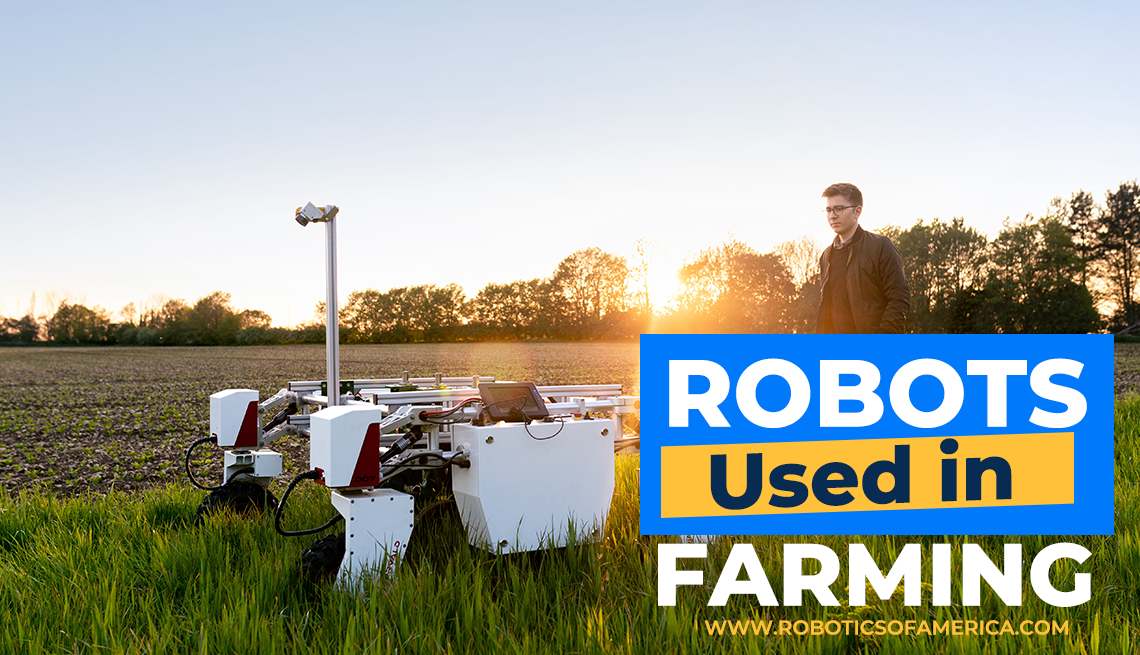
Robots Used in Farming
Having robots used in farming was only a concept you’d see in futuristic sci-fi movies. But not anymore. The agriculture industry is becoming more high-tech by the day. Many high-profile investors, companies, and technology professionals are getting in on the action. What is the end-goal? To boost the production abilities of a traditional farm across the world. And that is happening thanks to improvements in automation and robotic technologies.
Why is robotic system farming so important? The world population will grow by well over 2 billion people from now to 2050. That growth is putting pressure on farmers to deliver more commodities. In other words, humans will need more food. And farming robots will help the farmers produce more food. Let’s go in-depth into the amazing data collection in world of farming robots.
The Current Robots Used in Farming
1) Weeding robots used in farming.
Many robots used in farming help farmers get rid of weeds fast. Have you ever had a garden? If so, you know all about how annoying weeds can be. Getting rid of them is not easy and takes up a lot of time. That’s why commercial agriculturalists are turning to robots.
Sure, crop rotation practices can help reduce weeds. But many large-scale farmers still need to use herbicides. But herbicides are not an ideal long-term solution. Why? Because of two factors. 1. Plants are able to develop a resistance to weed killers. 2. Consumers are turning away from from food that's treated with chemicals. This means that a new solution must get developed. And what is the solution? Farming robots that can pull weeds fast. These weed-management robots got developed using advanced artificial intelligence. The AI ensures that the bots can tell the difference between weeds and crops. This prevents farmers from having to break their backs pulling weeds all day.
2) Crop-harvesting robots used in farming.
More and more robots used in farming are helping out with crop harvesting. Automation developments have led to robots becoming skilled at taking care of crops. There are plenty of reasons why farmers need help with crop-harvesting. For one, it requires a lot of physical movement. And let’s be realistic- it’s also very boring to do every single day. But thanks to robots, farmers now have more time in their days to focus on other important tasks.
Picking crops is not as easy as many people assume. Doing so requires having a delicate touch and a lot of skills. Here is an example of some of the crop-harvesting factors that farmers face. 1. A lot of fruits bruise while in the sun. 2. Vegetables that are leafy can get torn up with ease. Robotic technology has not gotten perfected enough yet to solve these problems. But crop-harvesting robots are already making a difference. Look for their technology limitations to lessen in the coming years. This will make the crop-harvesting robots more precise. Private sector agtech organizations are investing millions every year in developing the robots.
3) The Berry 5 robot used in farming for strawberry harvesting.
The Berry 5 is an example of a robot used in farming that benefits the consumer. Here is an example. Say you go to your local grocery store right now to buy some strawberries. Are you going to be all right with buying ugly, rotting strawberries? Of course not! Consumers always have demanded fresh strawberries that are easy on the eyes. Well, enter the Berry 5.
The Berry 5 is a strawberry harvesting robot created by Harvest CROO. That company is a startup that has gained a lot of notoriety in recent years. Why? Because they created one of the best strawberry-harvesting machines in the world. So, what makes the Berry 5 so special? Some farming robots use a single component, such as a robotic arm. Instead, the Berry 5 uses many components at once. The components allow the robots to take leaves, pick berries, and pack the berries. This series of actions can occur within seconds.
The Berry 5 maintains its success due to having computer vision. This technology assists the robot in deciding whether each berry is ripe enough. That’s right. This farming robot can decide on its own which berries are worthy enough for picking. But don't expect the Berry 5 to take all day making a decision. The technology enables the robot to make each decision in mere milliseconds. In fact, it has a reputation for picking an entire plant in under 8 seconds. It can then move on to the next plant in 1.5 seconds. You can already catch the Berry 5 hard at work in strawberry fields under the hot Florida sun. But you might soon see it in many more places. Harvest CROO is preparing to commercialize this robot on a global scale.
4) Lettuce-harvesting robots used in farming.
The Vegebot is another modern robot used in farming. It is an amazing lettuce-harvesting machine. As you may know, lettuce plants are very fragile. And they are also always very close to the ground. Factors like these led to the creation of Vegebot. Researchers at Cambridge University are the geniuses responsible for the robot's creation. Their team been struggling for quite some time to improve the lettuce harvesting. Their big break came when the team created a robot that was computer vision-powered. This ended up being the Vegebot prototype.
The Vegebot uses one camera to scan each lettuce leaf. It then decides in milliseconds whether the leaf is ready for harvesting. The Vegebot then uses a second camera by its blade to assist with picking the lettuce. The robot can pick each leaf with more delicacy and accuracy than humans are capable of. Each Vegebot's programmed with an advanced algorithm. That algorithm guides the robot to skip over diseased leaves or leaves that are not ripe enough.
Some farmers have complained that the Vegebot is not as fast as they would like it to be. But researchers are working hard to make the automated processes have more speed. In fact, that development is already taking place. Vegebots will soon be able to do more than pick lettuce. The Vegebots will be able to pick other above-ground vegetables, grains, and fruits. Think about it. If a robot is successful at picking iceberg lettuce, then it can pick other foods.
5) Fruit-sucking vacuum robots used in farming.
Many robots used in farming are going to need to have vacuum capabilities. Let’s use apple-sucking as an example. Abundant Robotics has created an amazing robot that specializes in sucking up apples. The robot looks like a suction tube attached to a small tractor. But don't let its weird appearance fool you. This robot is 100% state-of-the-art.
The apple-sucking robot uses advanced computer vision technology. The vision allows the robot to determine which apples to suck up. It can recognize which apples are unripe within a second or two. It then ignores those apples and gathers all the ripe ones. And get this. It uses an algorithm that allows a farmer to adjust the robot’s processes. Here is an example. Say a farmer's displeased with the apples that the robot is vacuuming. A lot of the apples are not ripe enough. The farmer then inputs a code into the robot so the robot knows to only suck up riper fruit. In the future, a feature like this will become a game-changer for a variety of farming robots. Have all the robots’s technical problems gotten solved? Not yet. But expect them to get solved within the next year or two.
6) Harvest automation robots used in farming.
Many robots used in farming get equipped with advanced automation features. And harvesting robots are no exception. The market for flowers, shrubs, and grasses is a multi-billion dollar industry. The commercial greenhouse sector will earn 40 billion dollars in the next four years. That is why harvest automation robots are in such high demand. Growers want to, well, grow their plants and grasses as fast as possible. And automated robots are shortening the growing process.
The HV-100 farming robot got designed by the inventors of the Roomba vacuum. This robot's tasked with spacing out plants and container crops. This is a physical, demanding job for any human. But the HV-100 never complains. Why does it make an effort to put space between plants and crops? Because greenhouse plants cannot grow unless there is plenty of open space. One major advantage of this robot is that high outside temperatures never affect it. No matter a farmer’s environment, this robot will take care of the harvesting process.
Conclusion: Robots Used in Farming Are Helping Farmers Succeed
It's obvious that autonomous robots used in farming are improving the operations of many farmers. They are saving farmers a lot of time while cutting a lot of costs but investment will increase with a billion by 2050. Look for the capabilities of the robots in this article to improve in the coming years. There is little limit to how robotics will impact agricultural companies. The future of farming is bright thanks to these amazing machine learning and solar power. Please come back to our website in the future for articles about:
- -agricultural robots future
- -agricultural robotics companies
- -the autonomous farming robot
- -robotics in agriculture in India
- -advantages of robots in agriculture
- -the history of agricultural robots
- -importance of robots in agriculture
- -how to make an agriculture robot

